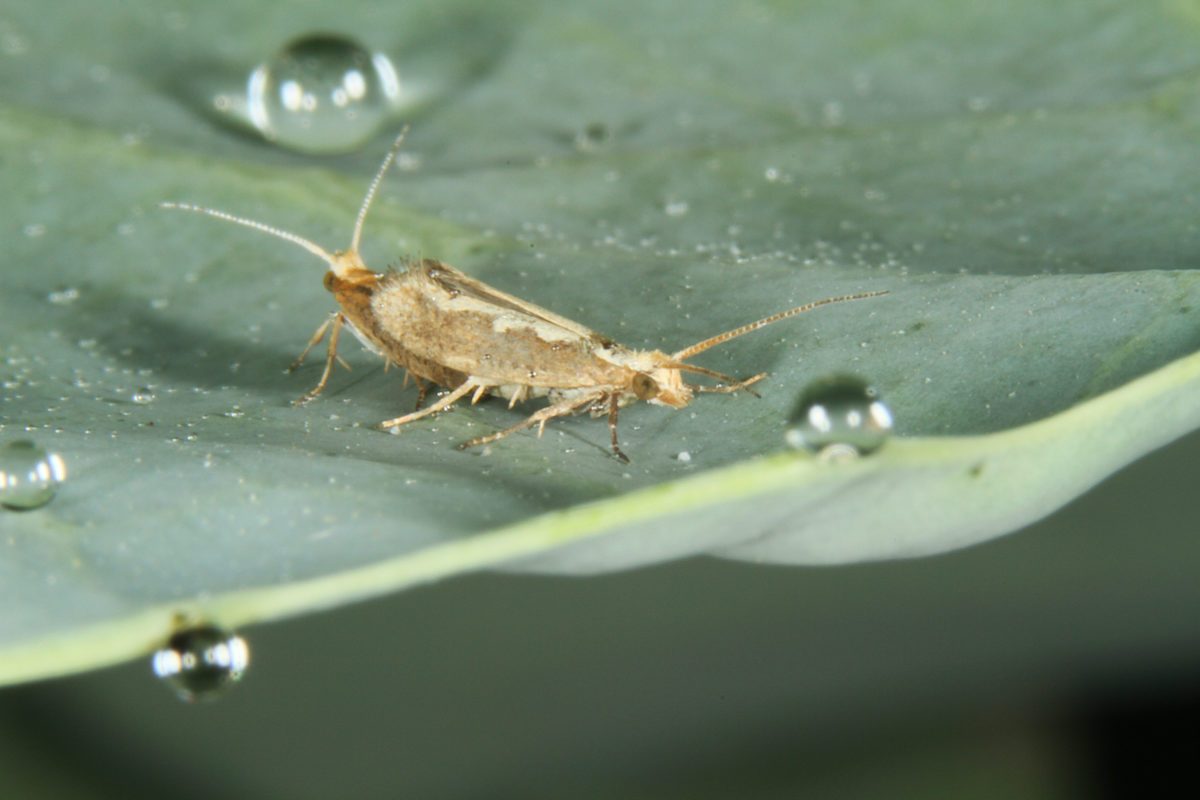The successful results of the first-ever open-field release of a genetically engineered, self-limiting insect pest were published today, offering new hope for reducing insecticide use in crops.
The study, conducted by scientists at Cornell University, aimed to assess the field behavior of a new strain of diamondback moth developed by Oxitec Ltd. and carrying a self-limiting gene.
The diamondback moth, also known as Plutella xylostella, is a destructive pest of brassica crops such as cabbage, broccoli, cauliflower and canola, causing $4-5 billion in losses annually. Researchers are searching for ways to control the pest without the use of insecticides by using genetics instead.
Oxitec’s self-limiting insects carry a gene that, when passed to offspring, prevents female caterpillars from surviving. Males with this gene are released to seek out and mate with wild females, resulting in fewer pest moths reaching adulthood in the next generation, thus crashing the pest population.
The new study marks a historic milestone because it describes the first open-field release of any self-limiting insect in North America, and the world’s first open-field release of a self-limiting, genetically engineered agricultural pest.
Entitled “First Field Release of a Genetically Engineered, Self-Limiting Agricultural Pest Insect: Evaluating its Potential for Future Crop Protection,” the study was published today in the peer-reviewed journal “Frontiers in Bioengineering and Biotechnology” and is free online for anyone to access.
The Cornell researchers, led by Professor Anthony Shelton in the Department of Entomology at Cornell University’s New York State Agricultural Experiment Station in Geneva, NY, found that the engineered strain of diamondback moth had similar field behaviors to unmodified moths.
After releasing the insects in several waves in a specially-planted circular cabbage field, the scientists subsequently recaptured the moths on pheromone traps and studied how far they had travelled and how many survived in real-world field conditions.
They found that 95 percent of the moths of both strains remained within 35 metres of the release sites, and that both strains had a similar longevity after release. The researchers conclude in the paper that this new data, combined with complementary laboratory studies on mating behavior, indicate that bi-weekly releases of Oxitec self-limiting male diamondback moths should “effectively suppress populations of pest P. xylostella in the field.”

The field test builds on previously published work in greenhouses by Shelton and colleagues that demonstrated sustained releases of the self-limiting strain effectively suppressed the pest population and prevented resistance developing to an insecticide — a win-win situation for pest control. And since it relies on mating to have an effect, it is target-specific, without the broad-spectrum effects often seen with insecticides.
Previous environmental releases of Oxitec insects have involved male Aedes aegypti mosquitos, genetically engineered with the same self-limiting gene, released in Brazil and other countries to tackle mosquito-borne diseases such as dengue, Zika, chikungunya and yellow fever.
The first field trial in Brazil of the second generation of self-limiting A. aegypti mosquitos, conducted by Oxitec in partnership with municipal disease-control authorities in four densely-populated communities in the city of Indaiatuba, found as high as 96 percent suppression of target mosquito populations.
Oxitec has also been developing a genetically-engineered self-limiting strain of fall armyworm, targeting a pest that has already caused devastating agricultural crop losses across sub-Saharan Africa, and has recently moved into India, China and other Asian countries.
While the “sterile insect technique” has been used in pest control for decades, previous efforts have used gamma radiation to sterilize males, which are then released to mate with wild females, thereby failing to produce viable offspring. In the world’s first field release of a genetically engineered insect, radiation-sterilized pink bollworm moths were released from 2006 in Arizona to provide a better-marked sterile insect in efforts to protect cotton fields from this caterpillar. However, the radiation used in this sterile approach also decreases the fitness of the male insects and makes them less effective as mates in the field.
This is the first time that a genetically engineered, self-limiting strain of an agricultural insect pest has been released anywhere in the globe, making the results of special interest to scientists eager to make a dent in the $19 billion chemical insecticides market with a more sustainable biological approach to crop protection.
“Our research builds on the sterile insect technique for managing insects that was developed back in the 1950s and celebrated by Rachel Carson in her book, Silent Spring,” said Shelton, a world-renowned expert in sustainable agriculture whose interest in entomology was sparked by Carson’s work. “Using genetic engineering is simply a more efficient method to get to the same end.”
Shelton added that mathematical models using the new field trial data and earlier results from laboratory studies give him confidence that releasing the self-limiting strain of diamondback moth “would control a pest population without the use of supplementary insecticides, as was demonstrated in our greenhouse studies.”
Dr. Neil Morrison, Oxitec’s agriculture lead and a co-author of the study, was also enthusiastic. “This study demonstrates the immense potential of this exciting technology as a highly effective pest management tool, which can protect crops in an environmentally sustainable way and is self-limiting in the environment,” he said.
